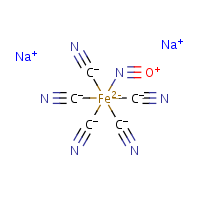Sodium nitroprusside
Agent Name
Sodium nitroprusside
CAS Number
14402-89-2
Formula
C5-Fe-N6-O.2Na
Major Category
Other Uses

Synonyms
Sodium nitroprusside anhydrous; Disodium nitrosylpentacyanoferrate; Nitroprussidnatrium [German]; Sodium nitroferricyanide; Sodium nitroprussate; Sodium nitroprussiate; Sodium nitrosylpentacyanoferrate; Sodium nitrosylpentacyanoferrate (III); Disodium pentacyanonitrosylferrate; Ferrate(2-), pentacyanonitrosyl-, disodium; Ferrate(2-), pentakis(cyano-C)nitrosyl-, disodium, (OC-6-22)-; Ferrate(2-), pentakis(cyano-kappaC)nitrosyl-, disodium, (OC-6-22)-; Ferrate(2-), pentakis(cyano-kappaC)nitrosyl-, sodium (1:2), (OC-6-22)-; [ChemIDplus] Sodium (OC-6-22)-pentakis(cyano-kappaC)nitrosylferrate(2-) (2:1); [Merck Index] UN3288
Category
Biochemical Research
Description
Crystals; [Sigma-Aldrich MSDS]
Sources/Uses
Used as a reagent for the detection of many organic and inorganic compounds and as an antihypertensive drug; [Merck Index] Nitroprusside is used intravenously in hypertensive emergencies. Side effects include tachycardia, rebound hypertension, and thiocyanate toxicity in patients with renal disease. [Cecil, 24th Ed, p. 388] "Cyanide released from NTP [nitroprusside] is detoxified by the enzyme-mediated transfer of sulfur from thiosulfate to cyanide. This irreversible reaction results in the synthesis of thiocyanate, which is then eliminated by the kidneys. . . . The amount of NTP that can be infused before the development of cyanide toxicity varies with the availability of thiosulfate stores. . . . Cyanide poisoning should be considered in any patient receiving NTP who develops cardiovascular instability of central nervous system abnormalities in the setting of an anion gap acidosis." [Ford, p. 407]
Comments
Effects from human intravenous administration include toxic psychosis, nausea or vomiting, metabolic acidosis, changes in cardiac rate, other cardiac changes, elevated blood pressure, regional or general arteriolar or venous dilation, changes in regional blood flow, convulsions, changes in pulse rate, hallucinations, and increased intracranial pressure; [RTECS] May cause irritation; Toxic by ingestion; May cause cyanosis; Targets the blood; [Sigma-Aldrich MSDS]
Biomedical References
Exposure Assessment
Explanatory Notes
The Guide in the Emergency Response Guidebook is for "Toxic solid, inorganic, n.o.s."
Adverse Effects
Neurotoxin
Other CNS neurotoxin
Diseases, Processes, and Activities Linked to This Agent
Other Information
No other related information on this agent was found.